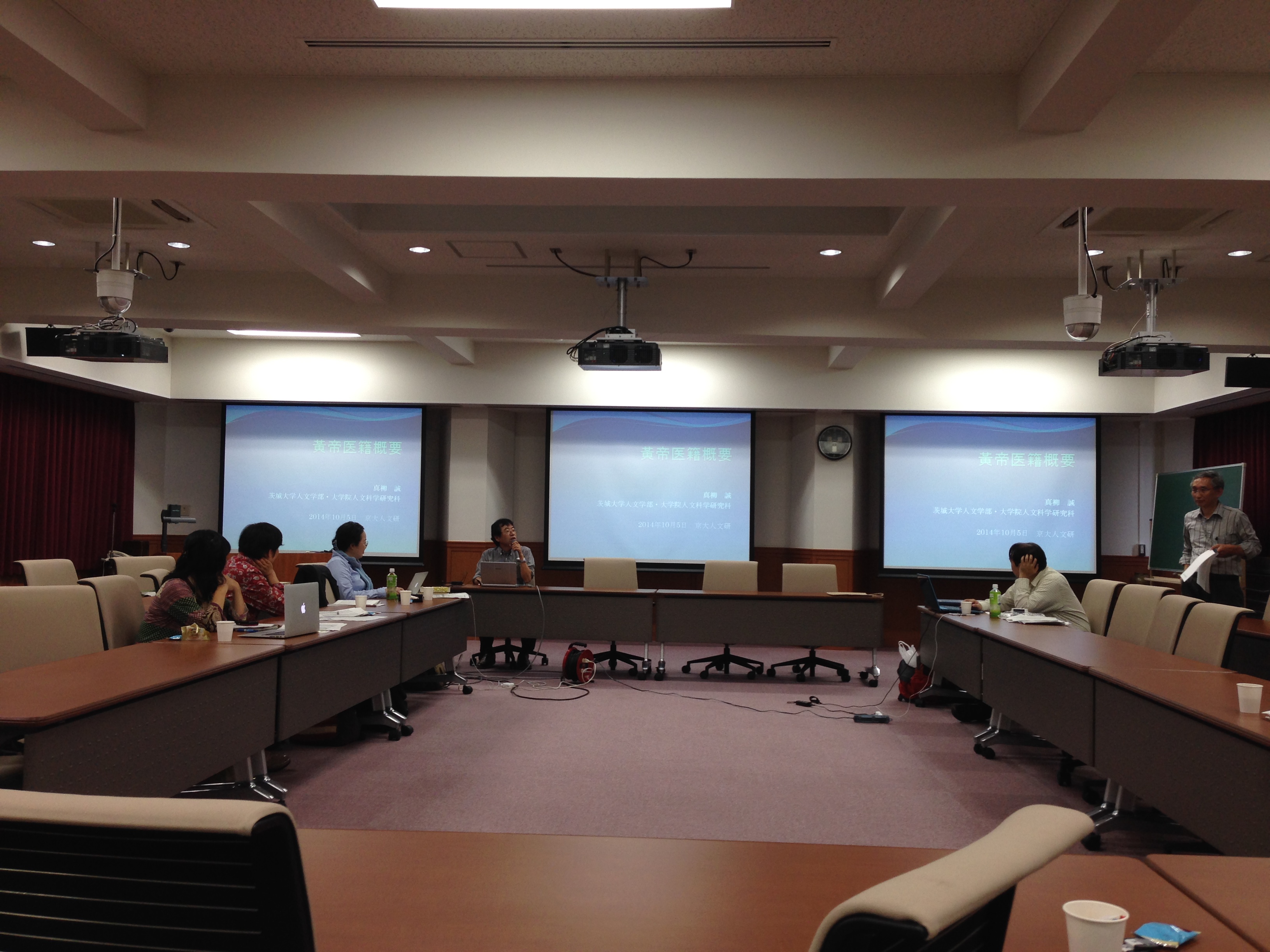
2014.10.5 Kyoto University, Institute for Research in Humanities
Professor Takeda today read a passage on Beriberi (Pek. Jiaoqi/ Jp. kakke) 腳氣 from the Ishinpō 医心方, the oldest Sino-Japanese medical treatise extant (984 CE).

There was some discussion on the exact nature of this disease and whether it corresponds to beriberi, the disease associated with the deficiency of thiamine or vitamin B1. Thiamine is the first water-soluble vitamin discovered and its discovery was connected to beriberi, namely the exclusive consumption of polished or dehusked rice leading to thiamine deficiency. Beriberi itself refers to a cluster of symptoms and the lower body, especially area below the knees, is often affected. This is likely the origin of the Chinese name Jiaoqi, literatally “feet-qi” or [discruption of] vital energy in the feet.
According to a study by Liao Yuqun 廖育群, “A Study of the Disease Called Kakke in the Edo Period” 江戸時代の脚気について(日本研究, 07/1996, 巻 14), Jiaoqi 腳氣 was first used as a name of disease from the Jin 晉 Period (265-420). It was described in great details from the Tang period onward. The medical knowledge was then transmitted to Japan before the tenth century.
Besides Liao’s essay, there are two books on the subject:
廖温仁. 東洋脚気病研究 : 一名東洋脚気病史. 京都: カニヤ書店; 1936.
山下 政, ヤマシタ セ. 脚気の歴史: ビタミン発見以前. 東京: 東京大学出版会; 1983.
There is also another work on the same subject by Liao Yuqun in Chinese:
http://www.ihp.sinica.edu.tw/~medicine/conference/disease/liaoyu.PDF
The strange thing about jiaoqi is that most Chinese today do not know about this disease, at least not beriberi associated with thiamine-deficiency. Rather, jiaoqi was confused with the fungal infection of the feet, commonly known as athletic’s feet or Hong Kong foot as it is known in some parts of the world (including Hong Kong!).
There was some interesting discussion why it was called Hong Kong feet and the answer is far from settled.
http://okplaymayday.pixnet.net/blog/post/30253264
How about origin of the term beri-beri then? There appears to be at least two explanations, one from the Sinhalese meaning “cannot cannot”, the other from Malay/Indonesia biri-biri meaning “trembling”. Prof. M. Mayanagi of Ibaraki University follows the Indonesian explanation, which of course is closely connected with the reports of the disease by the Dutch in the Dutch Indies (Indonesia) as early as the 17th century. I checked with my Indonesian and Sri Lankan colleagues. It seems that neither beri nor biri mean anything in contemporary Bahasa Indonesia (except beri for “berry”). As for Sinhalese, beri is the adjectival form of “behe” which means cannot, hence “being unable”. It however does not convey the sense of weakness. So there is still a bit of mystery and perhaps someone has worked on this problem already.
But what brought about the confusion between these two diseases among the Chinese? One explanation is that the Northern Chinese migrated to the South since before the Jin Period and began to develop problems with their feet after subsisting exclusively on rice instead of wheat. Jiaoqi as beriberi was thus considered a disease endemic to the South 風土病. As both beri-beri and fungal infection were thought to be caused by excessive heat and humidity of Southern China, hence the two became confused. Beri-beri eventually became a rarity in Southern China, as the region especially along the coast became prosperous, boasting some of the most delightful regional Chinese cuisines (Cantonese, of course) as well as a well-balanced diet (second only to Okinawan). Meanwhile, jiaoqi became exclusively associated with fungal infection of the feet — a problem for people with sweaty feet and not only in Hong Kong. Please!
Luckily I have not met anyone with either beri-beri or athletic feet. But this issue with polished rice consumption does have an interesting connection with my family history. My last name Mak 麥 (pek.Mai, jp.baku/mugi) is an ancient last name originated in Ling Nam 岭南 (pek. Lingnan) region, that is, the Cantonese region. According to the family book 族譜 past down to us, our earliest ancestor is traced back to the time of the famous Buddhist Emperor Liang (r. 502 – 549 CE). The most illustrious Mak who was recognized as our forefather was “Mak the iron staff” 麥鐵杖公 who was a warrior during the six dynasties in the late sixth century. He was a decorated general for the two Sui emperors and fought a number of important battles against the Turkic invaders in the northern frontier. There was a certain legend which tells that after General Mak the Iron Staff fought a number of battles, the Sui Emperior Wen 隋文帝 asked what reward he desired. The general, out of modesty, replied that he wished to have everyday just enough wheat grain to subsist and hence the surname Mak was given to him by the emperor. The legend implies that General Mak had a different last name before or no surname at all.
I thought the legend is quite interesting because wheat is not grown in the south, and even today we subsist mostly on rice, and especially the kind of nice white polished rice which leads to thiamine deficiency and beri-beri. Wheat is indeed a more complete foodstuff and should make up the preferred diet for the warriors. Even today, in Northern China, rice is often eaten as a side dish at the end of the meal on its own, unlike in the South where it is the main carbonhydrate one consumes together with the other delicious dishes. During those years I live in Beijing, I always thought the food was kind of bland, rough and lacked variety. I definitely missed my rice. Somehow I was quite healthy. Maybe just like in Herodutus’ History, when Cyrus refused to leave his barren Persian homeland to move to the fertile Babylonia, claiming that “soft lands breed soft men”. I believe that goes with the food as well. Of course, the Buddhists have totally different views but I will think about that another time.
